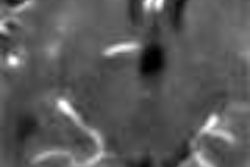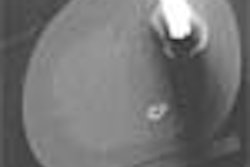In perhaps the largest study so far to gauge opinions on colorectal cancer screening methods, virtual colonoscopy won out over both conventional colonoscopy and double-contrast barium enema (DCBE). The study, from the Mayo Clinic in Rochester, MN, comes on the heels of similar European results presented in March.
It’s not as if the subjects mistook virtual colonoscopy for a bed of roses. Most participants said the bowel cleansing needed for all types of exams was uncomfortable and inconvenient. Nor was the virtual exam itself significantly more comfortable than colonoscopy, though it was certainly faster, and less burdensome than DCBE.
Where VC won hands-down was in future screening plans -- an important measure of any test's success. The next time around, patients overwhelmingly said they would prefer virtual colonoscopy over either the conventional kind or DCBE. And with virtual colonoscopy, they were willing be screened more frequently.
"Effective neoplasm detection is a function of both test sensitivity and user rate," wrote Dr. Thomas Gluecker and colleagues in the May issue of Radiology. "Assessment of a sample of patient perceptions and preferences may provide insight into the likelihood of (screening exam) use. To date, few data are available concerning patient attitudes toward and preferences for CT colonography in comparison to other screening approaches...However, these studies have been either preliminary or small in size, or they have not involved direct comparisons."
Gluecker, along with Dr. C. Daniel Johnson, Dr. William S. Harmsen, and colleagues based their results on the experiences of 1,313 patients in two groups. The first group underwent both VC and colonoscopy (n=696) and the second group had VC plus DCBE (617) (Radiology, May 2003, Vol. 227:2, pp. 378-384).
One day before the exams, VC/colonoscopy patients underwent standard bowel cleansing by ingesting polyethylene glycol electrolyte solution (GoLytely, Braintree Laboratories, Braintree, MA) a clear liquid diet, and oral bisacodyl laxative (10 mg) the next morning.
The day before DCBE, patients undergoing this procedure were allowed only a clear liquid diet, plus 300 mL of magnesium citrate and 20 mg of oral bisacodyl. Most conventional colonoscopy patients were sedated with a combination of midazolam hydrochloride (Versed) and meperedine hydrochloride (Demerol), both from Abbot Laboratories of Abbott Park, IL. Sedation was not used routinely for DCBE, but glucagon was administered at the discretion of the staff radiologist.
Patients were "gently" insufflated with CO2 before virtual colonoscopy, and after a subcutaneous injection of 1 mg glucagon to minimize colon spasms, the authors wrote. Patients underwent CT imaging on either a HiSpeed Advantage single-detector machine, or a LightSpeed multidetector scanner (GE Medical Systems, Waukesha, WI).
The single-detector scanner was set at 5-mm collimation, pitch 1.3, 3-mm reconstruction intervals, 70 mAs, 120 kVp, a 512 x 512 matrix, and a standard reconstruction algorithm. Acquisition parameters for the multidetector machine included 4 x 5-mm collimation, pitch 6, 3-mm reconstruction intervals, 40 mAs, 120 kVp, and a 512 x 512 matrix.
The questionnaires, completed and mailed in at least 12 hours after the second exam, were designed to elicit patient experiences with each exam, discomfort levels in both the exam and the cleansing procedure, and, finally, a preference for which exam the patients might prefer the next time.
The preparation
Most patients in both groups said preparation was uncomfortable. Of the 515 Group 1 patients who received the polyethylene glycol solution plus bisacodyl, 61 (12%) reported severe discomfort, 395 (77%) had mild or moderate discomfort, and 55 (11%) reported no discomfort.
In Group 2, of the 538 subjects who had the DCBE preparation, 44 (8%) reported severe discomfort, 434 (81%) had mild or moderate discomfort, and 56 (10%) reported no discomfort.
No significant difference in discomfort was reported between the two types of preparation (p=0.14).
The exams
Most of the Group 1 patients reported mild or absent discomfort at both virtual (98%) and conventional colonoscopy (96%), and while conventional was slightly less comfortable, the difference between the two was not statistically significant (p=0.63), and in both, patients experienced less discomfort than they expected (p<0.001). With DCBE, 29.3% experienced severe or extreme discomfort, while 55% had moderate discomfort, the researchers wrote.
As for willingness to repeat screening, 36.9% of subjects were willing to repeat virtual colonoscopy in one year, versus 26.5% for the conventional exam. At three years, about 50% of subjects were willing to repeat both colonoscopy and virtual colonoscopy. Omitting bowel preparation significantly improved subjects' willingness to undergo CT colonography or colonoscopy; however, patients were still more willing to undergo CT colonography at shorter intervals than colonoscopy (p< 0.001), the authors wrote. Willingness to repeat DCBE was 9.3% at one year, 32.4% at three years, and 41.7% at five years.
Finally, the subjects were asked which exam they would prefer to have next time. In Group 1, 357 subjects (72.3%) would choose virtual colonoscopy, versus 112 subjects (22.7%) who said it made no difference, versus 25 (5%) who said they would prefer conventional colonoscopy next time. Only 0.4% preferred DCBE over virtual colonoscopy, and no data were provided for DCBE vs. conventional colonoscopy.
"CT colonography (VC) was preferred by a wide margin over the other two types of colorectal examinations," the authors wrote. "Reasons for this preference were not specifically solicited... The minimal discomfort experienced at CT colonography might be explained by the brief examination time, the care taken to avoid overdistension of the colon, and the use of glucagon... This policy is consistent with and reflects common practice."
Most patients said the discomfort from cleansing was worse than the exams, and since virtual colonoscopy is the only method with the potential of eliminating purgative bowel cleansing, this point could benefit VC in the future, they added.
"Our questionnaire responses show that patients consider (virtual colonoscopy) to be more comfortable than either colonoscopy or DCBE, and suggest the possibility of a higher rate of compliance with (virtual colonoscopy)," they concluded. "These findings should be considered when modeling future colorectal cancer screening algorithms."
By Eric BarnesAuntMinnie.com staff writer
May 30, 2003
Related Reading
Patients prefer virtual colonoscopy over the other kind, May 3, 2003
VC screening trials find good sensitivity, high patient acceptance, October 30, 2002
Toward a CRC screening strategy: gastroenterologists take the stage, June 3, 2002
Copyright © 2003 AuntMinnie.com




















